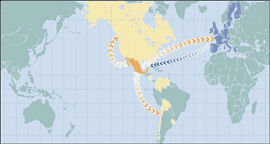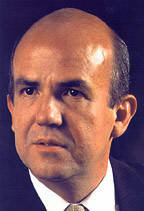 Solidifying
its Global Alliances Solidifying
its Global Alliances
Since the 1994 signing of the North American Free Trade Agreement (NAFTA ), Mexican exports to the U.S. have increased by 170%, according to Trade and Industry Minister Blanco.
The EU-Mexico Free Trade Agreement, officially signed March 23 will expand Mexico's potential as a very important industrial center between Europe and the U.S. Many products and services will be entering either way through Mexico, and this will represent an enormous development opportunity for many sectors. The efficient working class and some of the best infrastructure facilities in the world are also incentives for investors looking for reasons to enter the market.
Mexico's strategic geographic position has given it access to myriad markets, and with nine trade agreements under its belt and 15 more on the verge of approval, Blanco has room to boast. "With the European free trade agreement plus the trading network we are building in Central and South America, we will become a really unique place to invest," Blanco underlined. Entering the Mexican market will give investors access not only to the 100 million-strong consumer nation, but also to the world's largest trade alliances. Mexico has already woven a Latin American trade tapestry connecting Costa Rica, Nicaragua, Colombia, Venezuela, Bolivia, Chile and Mercosur member Uruguay. It is also in talks with the region's largest nation and Mercosur heavyweight - Brazil. Coming to terms with Brazil may mean that Mexico could negotiate an agreement with the Mercosur trade bloc, since it has already received positive feedback from members Uruguay, Paraguay and Argentina.

Expanding its trade prowess into Central America, Mexico is nearing an accord with the Northern Triangle, composed of Guatemala, Honduras and El Salvador. Mexico also just closed a trade deal with Israel in March, the only nation in Latin America to be in such a position, and is in talks with Japan and Singapore. "This really converts Mexico into the center of investment," the Business Coordinating Council (CCE)'s President Jorge Marin highlighted. Mexico's trade agreements altogether give it preferential treatment in 60% of the global market. More than a natural increase in the amount of annual trade exchanged, Mexico will look forward to greatly incremented European investment in the nation. Though the EU's global exports totaled $160 billion in 1998, of which 1% went to Mexico, should the EU increase its goods sent to Mexico to 2- 3%, it would mean investments near $6 billion.
|
 Ensuring
the Future with Foreign Investments Ensuring
the Future with Foreign Investments
Over the last six years, the nation boasts that "the amount of direct foreign investment has tripled to an average $11 billion per year," Blanco outlined, with expectations to top that this year. Foreign companies have committed to $12.377 billion of investments in Mexico for 2000, a 7% increase over last year, a survey by the Banco de Mexico and the Mexican Investment Board showed. These higher rates of commitment reflect confidence that Mexico's prudent monetary policies are approved by market watchers.
Companies like the Mexican Investment Board are digging into the new lucrative facets of the market, finding its niche in promoting foreign firms to discover the relatively low risk for an emerging market that Mexico offers. President of the Mexican Investment Board, Dr. Herman Von Bertrab , sees his company's forte in providing detailed expert information on the nation's industries and matchmaking Mexican and foreign companies to create strategic alliances. In doing so, it participates "in the industrial development of the country, and at the same time helps big industries to increase productivity rates," Von Bertrab explained.

Blanco expects a 5% annual growth rate of FDI, and
more investment is almost a guarantee with the recently
inked Free Trade Agreement with the European Union,
estimated to average at least $14 to $15 billion
annually in coming years.Europe currently is Mexico's
second most important trade partner, though it is
by far outstripped by the United States. Last year
Mexican exports to Europe totaled $4.5 billion,
while exports to the U.S. totaled $100 billion.
"Bear in mind," said Blanco, "Europe is a larger
market than the United States; we see substantial
potential in the exporting side." The EU agreement
also serves to diversify Mexico's export markets.
"No one wants to have all the eggs in just one basket,"
said the president of the National
Industrial Chamber ,
or CANACINTRA , Vicente
Yañez Solloa . This makes sense, considering
that most analysts label a U.S. economic slowdown
as the most negative potential effect overshadowing
the nation's advances. |

